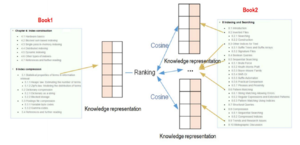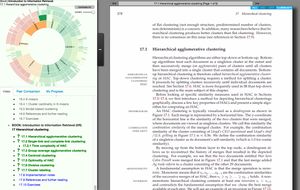Difference between revisions of "Open Corpus Personalized Learning"
(→The Project Team) |
m |
||
| (61 intermediate revisions by 7 users not shown) | |||
| Line 1: | Line 1: | ||
Goal: This project challenges the assumption that adaptive hypermedia systems require expensive knowledge engineering for domain and content modeling. It replaces carefully-crafted domain model with automatically-created domain models, lowering the cost of developing adaptive educational hypermedia software while also providing a wider range of instructional paths through the content. Adaptive educational hypermedia is known for its ability to improve learning outcomes and engagement maximizing educational opportunity for learners with different levels of knowledge. The development of this more automatic, open-corpus approach to adaptive educational hypermedia will increase the volume and the variety of resources available for meaningful online learning, especially for individuals learning on their own. Automatic knowledge indexing of educational content makes the system easy to maintain and update over time. These new open corpus user modeling techniques automatically adapt user models and personalized guidance to new materials as they are acquired. The ability to automatically organize, index, and adaptively recommend distributed educational content without the need of manual processing by system developers, enables new material to be integrated dynamically and with minimal effort in response to student needs. | Goal: This project challenges the assumption that adaptive hypermedia systems require expensive knowledge engineering for domain and content modeling. It replaces carefully-crafted domain model with automatically-created domain models, lowering the cost of developing adaptive educational hypermedia software while also providing a wider range of instructional paths through the content. Adaptive educational hypermedia is known for its ability to improve learning outcomes and engagement maximizing educational opportunity for learners with different levels of knowledge. The development of this more automatic, open-corpus approach to adaptive educational hypermedia will increase the volume and the variety of resources available for meaningful online learning, especially for individuals learning on their own. Automatic knowledge indexing of educational content makes the system easy to maintain and update over time. These new open corpus user modeling techniques automatically adapt user models and personalized guidance to new materials as they are acquired. The ability to automatically organize, index, and adaptively recommend distributed educational content without the need of manual processing by system developers, enables new material to be integrated dynamically and with minimal effort in response to student needs. | ||
| − | This project merges research on text analysis, human learning, and personalization to enable open corpus personalized learning. It develops its models of the domain and human learning from an initial set of well-organized, manually selected materials. Automatic text analysis creates an ensemble of domain models with different characteristics. Each individual model may be flawed or incomplete, however collectively they provide comprehensive coverage of the topic from several perspectives, thus reducing the manual effort required to create adaptive educational hypermedia. Multiple perspectives also give the system more flexibility in how to guide each student. These domain models are used as a foundation for building and maintaining dynamic models of user knowledge. The ensemble of domain and user models is used to deliver reactive and proactive adaptive guidance in an open corpus context. The growth of a person's knowledge is inferred by observing learner behavior and obtaining occasional feedback. This exploratory research opens the way to open corpus personalized learning. The domain modeling, user modeling, and personalization techniques developed in this research will be evaluated using a multi-layer framework that includes assessment by subject experts, performance prediction, cross-validation, and user studies. | + | This project merges research on text analysis, human learning, and personalization to enable open corpus personalized learning. It develops its models of the domain and human learning from an initial set of well-organized, manually selected materials. Automatic text analysis creates an ensemble of domain models with different characteristics. Each individual model may be flawed or incomplete, however, collectively they provide comprehensive coverage of the topic from several perspectives, thus reducing the manual effort required to create adaptive educational hypermedia. Multiple perspectives also give the system more flexibility in how to guide each student. These domain models are used as a foundation for building and maintaining dynamic models of user knowledge. The ensemble of domain and user models is used to deliver reactive and proactive adaptive guidance in an open corpus context. The growth of a person's knowledge is inferred by observing learner behavior and obtaining occasional feedback. This exploratory research opens the way to open corpus personalized learning. The domain modeling, user modeling, and personalization techniques developed in this research will be evaluated using a multi-layer framework that includes assessment by subject experts, performance prediction, cross-validation, and user studies. |
==The Project Team== | ==The Project Team== | ||
<gallery> | <gallery> | ||
Image:Peter.jpg|'''[[User:Peterb | Peter Brusilovsky]]'''<br/>Director | Image:Peter.jpg|'''[[User:Peterb | Peter Brusilovsky]]'''<br/>Director | ||
| − | Image:Daqing_He.png|'''[ | + | Image:Daqing_He.png|'''[http://www.pitt.edu/~dah44/ Daqing He]'''<br/>Co-director |
| − | Image:yunhuang.png|[[ | + | Image:Yun_Acadamic.png|[http://columbus.exp.sis.pitt.edu/yunhuang/index.htm Yun Huang] |
| + | Image:shuguang.png|[http://www.pitt.edu/~shh69/ Shuguang Han] | ||
| + | Image:rui.png|[http://memray.me/ Rui Meng] | ||
| + | Image:Sanqiang.png|[http://pitt.edu/~sanqiang Sanqiang Zhao] | ||
Image:Jordan.jpeg|[http://pitt.edu/~jab464 Jordan Barria-Pineda] | Image:Jordan.jpeg|[http://pitt.edu/~jab464 Jordan Barria-Pineda] | ||
| − | Image: | + | Image:Avatar.jpg|[http://pitt.edu/~hkc6 Hung Chau] |
| + | Image:k.thaker.png|[http://kthaker.com Khushboo Thaker] | ||
| + | |||
</gallery> | </gallery> | ||
| + | |||
| + | ==Education Content Linking== | ||
| + | {| | ||
| + | |valign="top" | [[ Image:Content-linking.png|thumb|left|'''100'''|Concepts Backbone connecting Educational Systems]] | ||
| + | |valign="center" | | ||
| + | Digitization has brought a significant change to the educational sector in the past ten years, making digital textbooks a convenient and popular resource for learning. Starting as merely a digital copy of paper textbooks, digital textbooks gradually integrated a number of innovative and advanced functionality. Rapid digitization also remarkably increased the volume of open learning resources, which have grown very popular, providing learners with great opportunities to expand their learning. Moreover, these new digital learning resources could be combined with the traditional learning process. For example, a learner may come across the concept of ``Indexing'' while reading a textbook on ``Information Retrieval''. This triggers her to engage extra online materials on ``Indexing'' to learn the state-of-the-art practical methods or research trends. | ||
| + | |||
| + | The goal of the project is to address this challenge by providing links to related content at different textbook materials. In this project, we would like to use concepts as a backbone for connecting different education materials. This is a challenging task since textbooks and online materials are written by different authors, for different audiences, and frequently use different terms/words to express the same concepts. Furthermore, many domains lack formal domain models or ontologies, where all domain concepts are listed and organized. Therefore, the association of terms and concepts, and the representation of concepts should be automatically discovered and constructed. | ||
| + | |||
| + | To address these challenges, our work applies distributed neural representations, which demonstrated an ability to solve the term-mismatch problem by transferring the representation of terms to an N-dimension continuous vector (also called embedding). The expectation is that terms or words which share the same semantic meaning will be nearer in this N-dimensional continuous vector space. | ||
| + | |} | ||
| + | |||
==Knowledge Extraction== | ==Knowledge Extraction== | ||
| + | {| | ||
| + | |valign="top" | [[ Image:Knowledge-linking-Illustration.png|thumb|left|'''100'''|Dynamic Linking Textbooks]] | ||
| + | |valign="center" | | ||
| + | The Internet has dramatically increased both the volume and variety of online educational resources, such as online textbooks, online courses, and tutorials. The development of modern search techniques has further promoted the quick access of these resources. However, most of these educational resources are not well-structured, which imposed an important challenge -- readers without sufficient background knowledge may be difficult to understand its content. To achieve the goal of recommending ''the right content'' that matches individuals' knowledge levels, the first critical step is to provide a better organization for educational resources. The project visions two important components when organizing educational resources: (1) knowledge concept extraction; and (2) concept hierarchy extraction. Traditional solutions for these two problems heavily rely on experts' manual efforts which are time-consuming and unscalable. | ||
| + | |||
| + | Our goal for knowledge extraction is to provide a scalable solution for the above two problems. We pilot our study with extracting knowledge structures from textbooks since they provide a comprehensive list of concepts and are often used as major educational resources in schools, colleges and universities. In addition, textbooks are also equipped with structural information such as table of contents and glossaries, which are very helpful in identifying concepts and their relationships. | ||
| + | |||
| + | |||
| + | However, the automated extraction of knowledge concepts. Accurately extracting knowledge concepts from educational content is a challenge since the miss of a large-scale knowledge concept labels for building reliable machine learning algorithms. Considering the high time cost for expert-based labeling, we explore an alternative crowdsourcing-based, with restricted quality control, approach. That is, we distribute our knowledge concept labeling work to massive crowdsourcing workers, and further aggregate the obtained labels based on well-developed quality control methods in crowdsourcing. So far, we have built our annotation system and conducted several pilot studies. In the future, we would like to conduct a live experiment to examine the validity of this approach. | ||
| + | |} | ||
| + | |||
| + | == Learner Modeling == | ||
| + | {| | ||
| + | |valign="top" | [[Image:ReadingLearningProcess.png|thumb|left|'''100'''|Dynamic Knowledge Modeling in Textbook Reading]] | ||
| + | |valign="center" | We have recently proposed a data-driven framework for [[Dynamic Knowledge Modeling in Textbook-Based Learning| dynamic knowledge modeling in textbook-based learning]] (UMAP 2016). We formulated the problem of modeling learning from reading as a reading-time prediction problem, reconstructed existing popular student models (such as Knowledge Tracing) and explored two automatic text analysis approaches (bag-of-words-based and latent semantic-based) to build the KC model. This framework can be applied to a broader context of open-corpus personalized learning, empowering learners with the ability to access the right reading content at the right moment, despite the huge volume of online educational content. We are also working on applying [[Feature-Aware Student knowledge Tracing (FAST)|Feature-Aware Student knowledge Tracing (FAST)]] which is our new learner model proposed in 2014 with state-of-the-art predictive performance into textbook-based learning environment. | ||
| + | |||
| + | Over past years, our lab has developed [[CUMULATE]], a centralized user modeling server built for the [[ADAPT2]] architecture, to provide user modeling support for adaptive educational hypermedia (AEH) systems. We have proposed and implemented different learner models , including [[CUMULATE asymptotic knowledge assessment|asymptotic assessment of user knowledge]]. We have explored different aspects to improve learner modeling, including reducing the content model, better evaluation for practitioners and applying network (graph) analysis. | ||
| − | + | * [[Dynamic Knowledge Modeling in Textbook-Based Learning|More about dynamic knowledge modeling in textbook-based learning]] | |
| + | * [[Learner Modeling|More about learner modeling]] | ||
| + | * [[Feature-Aware Student knowledge Tracing (FAST)|More about Feature-Aware Student knowledge Tracing (FAST)]] | ||
| + | * [[CUMULATE|More about CUMULATE]] | ||
| + | * [[CUMULATE asymptotic knowledge assessment|More about asymptotic assessment of user knowledge]] | ||
| + | |} | ||
==The Experimental Platform== | ==The Experimental Platform== | ||
| + | |||
| + | In order to support students' learning in the classroom environment, we have implemented a web platform for students to access class materials including textbooks, research publications, web tutorials, etc. More importantly, the system automatically records users' reading behaviors in order to be able to build their student models based on this data. By now, the reading system is able to render material in two formats: | ||
| + | * Image-based | ||
| + | * HTML-based (not tested yet in classroom studies) | ||
| + | We plan to support pdf document rendering soon. | ||
| + | |||
| + | [[Image:ReadingSystem_122016.jpg|thumb|left|alt=Current reading platform.|The experimental Reading System.]] | ||
| + | |||
| + | The reading system is basically formed by 2 main parts: | ||
| + | * The reader itself (see right side of the figure) | ||
| + | * The student reading data section (see left side of the figure) | ||
| + | |||
| + | In the student reading data section, the users can have access to two information sources. The first one is a sunburst hierarchical visualization tool (see upper section) that allows them to know their progress in the reading of the contents that are associated with the course using a color scale encoding from red (non-read) to green (totally read). The former version of this visualization tool is called [[ReadingCircle]]. | ||
| + | The second one (see lower section) is the hierarchical index of the group, where each section | ||
| + | The system is created for including learning material following a hierarchical structure in a similar way as books are structured (chapter, subchapter, section, etc.). In addition to this, the system allows the inclusion of multiple choice questions at the end of each section with the aim of test the acquired knowledge of the students. | ||
==Publications== | ==Publications== | ||
| + | * Huang, Yun and Yudelson, Michael and Han, Shuguang and He, Daqing and Brusilovsky, Peter. "A Framework for Dynamic Knowledge Modeling in Textbook-Based Learning." In Proceedings of the 2016 Conference on User Modeling Adaptation and Personalization, pp. 141-150. ACM, 2016 ([http://d-scholarship.pitt.edu/28248/ paper]). | ||
| + | * Meng, Rui and Han, Shuguang and Huang, Yun and He, Daqing and Brusilovsky, Peter. "Knowledge-based Content Linking for Online Textbooks." In Proceeding of the 2016 IEEE/WIC/ACM International Conference on Web Intelligence, pp. 13-16. IEEE Computer Society, 2016. ([http://d-scholarship.pitt.edu/30486/1/wi16-knowledge-linking.pdf paper]). | ||
| + | * Meng, R., Zhao, S., Han, S., He, D., Brusilovsky, P., and Chi, Y. (2017) Deep Keyphrase Generation. In: Proceedings of ACL2017, Annual Meeting of the Association for Computational Linguistics, Vancouver, Canada, July 30-August 4, 2017 pp. 582-592. | ||
| + | * Labutov, I., Huang, Y., Brusilovsky, P., and He, D. (2017) Semi-Supervised Techniques for Mining Learning Outcomes and Prerequisites. In: Proceedings of the 23rd ACM SIGKDD International Conference on Knowledge Discovery and Data Mining, Halifax, NS, Canada, ACM, pp. 907-915. | ||
| + | * Thaker, K., Huang, Y., Brusilovsky, P., and He, D. (2018) Dynamic Knowledge Modeling with Heterogeneous Activities for Adaptive Textbooks. In: Proceedings of the 11th International Conference on Educational Data Mining, Buffalo, USA, July 15-18, 2018, pp. 592-595. [http://educationaldatamining.org/files/conferences/EDM2018/papers/EDM2018_paper_199.pdf paper] | ||
| + | * Thaker, K. M., Brusilovsky, P., and He, D. (2018) Concept Enhanced Content Representation for Linking Educational Resources. In: Proceedings of 2018 IEEE/WIC/ACM International Conference on Web Intelligence (WI), Santiago, Chile, December 3-6, 2018, IEEE, pp. 413-420. | ||
| + | * Barria-Pineda, J., Brusilovsky, P., and He, D. (2019) Reading Mirror: Social Navigation and Social Comparison for Electronic Textbooks. In: Proceedings of First Workshop on Intelligent Textbooks at 20th International Conference on Artificial Intelligence in Education (AIED 2019), Chicago, USA, June 25, 2019, CEUR, pp. 30-37. | ||
| + | * Thaker, K., Brusilovsky, P., and He, D. (2019) Student Modeling with Automatic Knowledge Component Extraction for Adaptive Textbooks. In: Proceedings of First Workshop on Intelligent Textbooks at 20th International Conference on Artificial Intelligence in Education (AIED 2019), Chicago, USA, June 25, 2019, CEUR, pp. 95-102. | ||
| + | * Thaker, K., Zhang, L., He, D., and Brusilovsky, P. (2020) Recommending Remedial Readings Using Student’s Knowledge State. In: Proceedings of 13th International Conference on Educational Data Mining, July 10-13, 2020, pp. 233-244. | ||
| + | * Yuan, X., Wang, T., Meng, R., Thaker, K., Brusilovsky, P., He, D., and Trischler, A. (2020) One Size Does Not Fit All: Generating and Evaluating Variable Number of Keyphrases. In: D. Jurafsky, J. Chai, N. Schluter and J. R. Tetreault (eds.) Proceedings of the 58th Annual Meeting of the Association for Computational Linguistics, Online, July 5-10, 2020, Association for Computational Linguistics, pp. 7961-7975. | ||
| + | * Chau, H., Labutov, I., Thaker, K., He, D., and Brusilovsky, P. (2021) Automatic Concept Extraction for Domain and Student Modeling in Adaptive Textbooks. International Journal of Artificial Intelligence in Education 31 (4), 820–846. | ||
| + | * Wang, M., Chau, H., Thaker, K., Brusilovsky, P., and He, D. (2022) Knowledge Annotation for Intelligent Textbooks. Technology, Knowledge and Learning, in press. | ||
Latest revision as of 16:34, 11 January 2023
Goal: This project challenges the assumption that adaptive hypermedia systems require expensive knowledge engineering for domain and content modeling. It replaces carefully-crafted domain model with automatically-created domain models, lowering the cost of developing adaptive educational hypermedia software while also providing a wider range of instructional paths through the content. Adaptive educational hypermedia is known for its ability to improve learning outcomes and engagement maximizing educational opportunity for learners with different levels of knowledge. The development of this more automatic, open-corpus approach to adaptive educational hypermedia will increase the volume and the variety of resources available for meaningful online learning, especially for individuals learning on their own. Automatic knowledge indexing of educational content makes the system easy to maintain and update over time. These new open corpus user modeling techniques automatically adapt user models and personalized guidance to new materials as they are acquired. The ability to automatically organize, index, and adaptively recommend distributed educational content without the need of manual processing by system developers, enables new material to be integrated dynamically and with minimal effort in response to student needs.
This project merges research on text analysis, human learning, and personalization to enable open corpus personalized learning. It develops its models of the domain and human learning from an initial set of well-organized, manually selected materials. Automatic text analysis creates an ensemble of domain models with different characteristics. Each individual model may be flawed or incomplete, however, collectively they provide comprehensive coverage of the topic from several perspectives, thus reducing the manual effort required to create adaptive educational hypermedia. Multiple perspectives also give the system more flexibility in how to guide each student. These domain models are used as a foundation for building and maintaining dynamic models of user knowledge. The ensemble of domain and user models is used to deliver reactive and proactive adaptive guidance in an open corpus context. The growth of a person's knowledge is inferred by observing learner behavior and obtaining occasional feedback. This exploratory research opens the way to open corpus personalized learning. The domain modeling, user modeling, and personalization techniques developed in this research will be evaluated using a multi-layer framework that includes assessment by subject experts, performance prediction, cross-validation, and user studies.
Contents
The Project Team
Peter Brusilovsky
DirectorDaqing He
Co-director
Education Content Linking
|
Digitization has brought a significant change to the educational sector in the past ten years, making digital textbooks a convenient and popular resource for learning. Starting as merely a digital copy of paper textbooks, digital textbooks gradually integrated a number of innovative and advanced functionality. Rapid digitization also remarkably increased the volume of open learning resources, which have grown very popular, providing learners with great opportunities to expand their learning. Moreover, these new digital learning resources could be combined with the traditional learning process. For example, a learner may come across the concept of ``Indexing while reading a textbook on ``Information Retrieval. This triggers her to engage extra online materials on ``Indexing to learn the state-of-the-art practical methods or research trends. The goal of the project is to address this challenge by providing links to related content at different textbook materials. In this project, we would like to use concepts as a backbone for connecting different education materials. This is a challenging task since textbooks and online materials are written by different authors, for different audiences, and frequently use different terms/words to express the same concepts. Furthermore, many domains lack formal domain models or ontologies, where all domain concepts are listed and organized. Therefore, the association of terms and concepts, and the representation of concepts should be automatically discovered and constructed. To address these challenges, our work applies distributed neural representations, which demonstrated an ability to solve the term-mismatch problem by transferring the representation of terms to an N-dimension continuous vector (also called embedding). The expectation is that terms or words which share the same semantic meaning will be nearer in this N-dimensional continuous vector space. |
Knowledge Extraction
|
The Internet has dramatically increased both the volume and variety of online educational resources, such as online textbooks, online courses, and tutorials. The development of modern search techniques has further promoted the quick access of these resources. However, most of these educational resources are not well-structured, which imposed an important challenge -- readers without sufficient background knowledge may be difficult to understand its content. To achieve the goal of recommending the right content that matches individuals' knowledge levels, the first critical step is to provide a better organization for educational resources. The project visions two important components when organizing educational resources: (1) knowledge concept extraction; and (2) concept hierarchy extraction. Traditional solutions for these two problems heavily rely on experts' manual efforts which are time-consuming and unscalable. Our goal for knowledge extraction is to provide a scalable solution for the above two problems. We pilot our study with extracting knowledge structures from textbooks since they provide a comprehensive list of concepts and are often used as major educational resources in schools, colleges and universities. In addition, textbooks are also equipped with structural information such as table of contents and glossaries, which are very helpful in identifying concepts and their relationships.
|
Learner Modeling
| We have recently proposed a data-driven framework for dynamic knowledge modeling in textbook-based learning (UMAP 2016). We formulated the problem of modeling learning from reading as a reading-time prediction problem, reconstructed existing popular student models (such as Knowledge Tracing) and explored two automatic text analysis approaches (bag-of-words-based and latent semantic-based) to build the KC model. This framework can be applied to a broader context of open-corpus personalized learning, empowering learners with the ability to access the right reading content at the right moment, despite the huge volume of online educational content. We are also working on applying Feature-Aware Student knowledge Tracing (FAST) which is our new learner model proposed in 2014 with state-of-the-art predictive performance into textbook-based learning environment.
Over past years, our lab has developed CUMULATE, a centralized user modeling server built for the ADAPT2 architecture, to provide user modeling support for adaptive educational hypermedia (AEH) systems. We have proposed and implemented different learner models , including asymptotic assessment of user knowledge. We have explored different aspects to improve learner modeling, including reducing the content model, better evaluation for practitioners and applying network (graph) analysis. |
The Experimental Platform
In order to support students' learning in the classroom environment, we have implemented a web platform for students to access class materials including textbooks, research publications, web tutorials, etc. More importantly, the system automatically records users' reading behaviors in order to be able to build their student models based on this data. By now, the reading system is able to render material in two formats:
- Image-based
- HTML-based (not tested yet in classroom studies)
We plan to support pdf document rendering soon.
The reading system is basically formed by 2 main parts:
- The reader itself (see right side of the figure)
- The student reading data section (see left side of the figure)
In the student reading data section, the users can have access to two information sources. The first one is a sunburst hierarchical visualization tool (see upper section) that allows them to know their progress in the reading of the contents that are associated with the course using a color scale encoding from red (non-read) to green (totally read). The former version of this visualization tool is called ReadingCircle. The second one (see lower section) is the hierarchical index of the group, where each section The system is created for including learning material following a hierarchical structure in a similar way as books are structured (chapter, subchapter, section, etc.). In addition to this, the system allows the inclusion of multiple choice questions at the end of each section with the aim of test the acquired knowledge of the students.
Publications
- Huang, Yun and Yudelson, Michael and Han, Shuguang and He, Daqing and Brusilovsky, Peter. "A Framework for Dynamic Knowledge Modeling in Textbook-Based Learning." In Proceedings of the 2016 Conference on User Modeling Adaptation and Personalization, pp. 141-150. ACM, 2016 (paper).
- Meng, Rui and Han, Shuguang and Huang, Yun and He, Daqing and Brusilovsky, Peter. "Knowledge-based Content Linking for Online Textbooks." In Proceeding of the 2016 IEEE/WIC/ACM International Conference on Web Intelligence, pp. 13-16. IEEE Computer Society, 2016. (paper).
- Meng, R., Zhao, S., Han, S., He, D., Brusilovsky, P., and Chi, Y. (2017) Deep Keyphrase Generation. In: Proceedings of ACL2017, Annual Meeting of the Association for Computational Linguistics, Vancouver, Canada, July 30-August 4, 2017 pp. 582-592.
- Labutov, I., Huang, Y., Brusilovsky, P., and He, D. (2017) Semi-Supervised Techniques for Mining Learning Outcomes and Prerequisites. In: Proceedings of the 23rd ACM SIGKDD International Conference on Knowledge Discovery and Data Mining, Halifax, NS, Canada, ACM, pp. 907-915.
- Thaker, K., Huang, Y., Brusilovsky, P., and He, D. (2018) Dynamic Knowledge Modeling with Heterogeneous Activities for Adaptive Textbooks. In: Proceedings of the 11th International Conference on Educational Data Mining, Buffalo, USA, July 15-18, 2018, pp. 592-595. paper
- Thaker, K. M., Brusilovsky, P., and He, D. (2018) Concept Enhanced Content Representation for Linking Educational Resources. In: Proceedings of 2018 IEEE/WIC/ACM International Conference on Web Intelligence (WI), Santiago, Chile, December 3-6, 2018, IEEE, pp. 413-420.
- Barria-Pineda, J., Brusilovsky, P., and He, D. (2019) Reading Mirror: Social Navigation and Social Comparison for Electronic Textbooks. In: Proceedings of First Workshop on Intelligent Textbooks at 20th International Conference on Artificial Intelligence in Education (AIED 2019), Chicago, USA, June 25, 2019, CEUR, pp. 30-37.
- Thaker, K., Brusilovsky, P., and He, D. (2019) Student Modeling with Automatic Knowledge Component Extraction for Adaptive Textbooks. In: Proceedings of First Workshop on Intelligent Textbooks at 20th International Conference on Artificial Intelligence in Education (AIED 2019), Chicago, USA, June 25, 2019, CEUR, pp. 95-102.
- Thaker, K., Zhang, L., He, D., and Brusilovsky, P. (2020) Recommending Remedial Readings Using Student’s Knowledge State. In: Proceedings of 13th International Conference on Educational Data Mining, July 10-13, 2020, pp. 233-244.
- Yuan, X., Wang, T., Meng, R., Thaker, K., Brusilovsky, P., He, D., and Trischler, A. (2020) One Size Does Not Fit All: Generating and Evaluating Variable Number of Keyphrases. In: D. Jurafsky, J. Chai, N. Schluter and J. R. Tetreault (eds.) Proceedings of the 58th Annual Meeting of the Association for Computational Linguistics, Online, July 5-10, 2020, Association for Computational Linguistics, pp. 7961-7975.
- Chau, H., Labutov, I., Thaker, K., He, D., and Brusilovsky, P. (2021) Automatic Concept Extraction for Domain and Student Modeling in Adaptive Textbooks. International Journal of Artificial Intelligence in Education 31 (4), 820–846.
- Wang, M., Chau, H., Thaker, K., Brusilovsky, P., and He, D. (2022) Knowledge Annotation for Intelligent Textbooks. Technology, Knowledge and Learning, in press.












